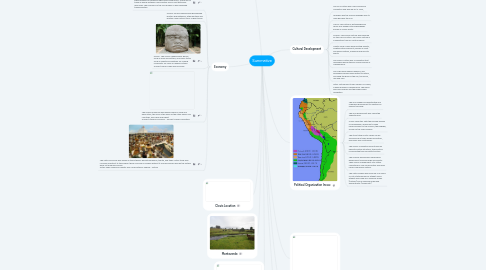Summative
by EMILIA VALENTINA OJEDA MURILLO

1. Social Organization
1.1. The Incas followed a strict social hierarchy system and according to this system, there were 4 main levels which were the Sapa Inca
1.2. Clovis
1.2.1. The Clovis First hypothesis states that no humans existed in the Americas prior to Clovis, which dates from 13,000 years ago,
1.3. the Folsom culture, also known as the Lindenmeier culture, replaced previous Clovis ways of life,
1.4. Monteverde: The Monteverde Conservation Association. It is a civil, non-profit organization, declared of Public Utility for the interests of the State.
1.5. Little is known about the Olmec social hierarchy, however it is believed that the Olmecs' social structure consisted of two main groups
1.6. The Aztecs followed a strict social hierarchy in which individuals were identified as nobles (pipiltin), commoners (macehualtin), serfs, or slaves.
2. Economy
2.1. Incas: Inca society developed an impressive economic system, which allowed for extensive agricultural production, as well as for trade of goods between communities across vast distances. resources :The economy of the Inca Empire: a well organized trading system
2.2. Folsom: Folsom people were generalized hunters and gatherers, although they also hunted a now-extinct form of giant bison
2.3. Olmec- The Olmec needed basic goods, such as food and pottery, and luxury items such as jadeite and feathers for making ornaments for rulers or religious rituals. Ancient Olmec Trade and Economy
2.4. The Mayan economy was largely based on food and agriculture, this form is the same as the other earlier civil countries, like China and Egypt. Ancient Mayan Economics - Ancient Mayan Civilization
2.5. The Aztec economy was based on three things: agricultural goods, tribute, and trade. Aztec trade was crucially important to the empire; there could be no empire without it as many goods used by the Aztecs were not produced locally. Aztec Trade: Regional Markets and Long Distance Trading - History
3. Clovis Location
4. Monteverde
5. Mayan:
6. Cultural Development
6.1. The Inca culture was a very advanced civilization and was led by 13 Incas,
6.2. Quechua was the official language and its main god was the Sun.
6.3. Clovis: The culture is distinguished by heavy leaf-shaped stone spearheads known as Clovis points.
6.4. Folsom: The Folsom culture was replaced by the Clovis Culture. The Clovis culture is a prehistoric tribe of North America.
6.5. Monte verde: There were hunting objects, architecultural elements, pieces of meat and animal leather, medicinal and exoctic plants.
6.6. The Olmec culture was a civilization that developed during the pre-classic period of Mesoamerica.
6.7. The Maya were deeply religious, and worshiped various gods related to nature, including the gods of the sun, the moon, rain and corn
6.8. Aztec culture had its own version of Ulama, a game played in Mesoamerica. The game was very popular and the players were celebrities.
7. Political Organization Incas:
7.1. The Inca needed a sophisticated and organized government to maintain an empire this large
7.2. The Inca government was called the Tawantinsuyu
7.3. Clovis made this faith the favored religion of his kingdom, which led to large repercussions for the Church, the kingship, as well as the Gallic people.
7.4. The story titled Monte Verde can be summed up in three words excavation, discovery and controversy.
7.5. The Olmec Civilization did not have an explicit political structure, their politics incorporated their societal structure.
7.6. The Mayans developed a hierarchical government ruled by kings and priests. They lived in independent city-states consisting of rural communities and large urban ceremonial centers.
7.7. The Aztec empire was made up of a series of city-states known as altepetl. Each altepetl was ruled by a supreme leader (tlatoani) and a supreme judge and administrator (cihuacoatl)
8. Location Folsom:
9. Olmec-
10. Aztec:


